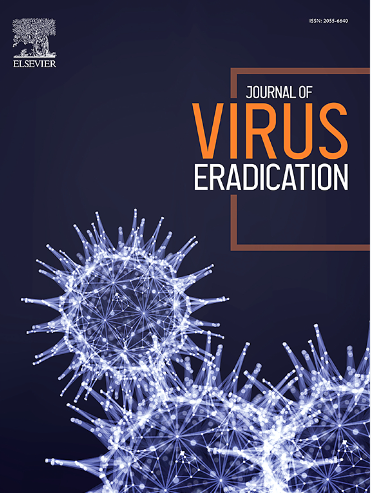HIV PrEP programmes as a framework for diagnosing and treating HBV infection in adolescents and young adults in KwaZulu-Natal, South Africa
IF 2
4区 医学
Q2 IMMUNOLOGY
引用次数: 0
Abstract
Background
Guidelines for Hepatitis B treatment released by the World Health Organization in 2024 include the potential for use of dual therapy, combining tenofovir with either emtricitabine or lamivudine. These fixed-dose combinations are also used for Pre-Exposure Prophylaxis (PrEP) in people at risk of Human Immunodeficiency Virus (HIV). We hypothesize that pre-existing HIV PrEP programmes can support access to HBV testing and treatment.
Methods
At the Africa Health Research Institute (AHRI) in KwaZulu Natal, South Africa, we evaluated PrEP uptake and retention amongst adolescents and young adults aged 15–30 years. We reviewed HBV status, acceptance of PrEP and retention in follow-up between June 2022–Sept 2024.
Results
15847 adolescents and young adults received an assessment in the community, of whom 3481/15847 (21.9 %) were eligible for sexual health prevention interventions. 3431/3481 (98.6 %) accepted HBV screening, of whom 21/3431 (0.6 %) tested positive for HBsAg. These 21 individuals had not previously been aware of their HBV status, but one was already on antiretroviral therapy for HIV infection. Amongst the others, 16/20 (80 %) were considered eligible for PrEP, and 15/16 started PrEP. When investigating retention in care, among 15 individuals due for a refill, 8/15 (53.3 %) returned at least once.
Conclusion
Sexual reproductive health and PrEP programmes provide an opportunity for HBV testing and treatment. However, attrition from the care cascade at each step highlights the pressing need for interventions that address barriers to sustainable delivery of long-term care.
艾滋病毒预防规划作为南非夸祖鲁-纳塔尔省青少年和青壮年乙型肝炎病毒感染诊断和治疗的框架
世界卫生组织于2024年发布的乙型肝炎治疗指南包括使用双重治疗的可能性,将替诺福韦与恩曲他滨或拉米夫定联合使用。这些固定剂量组合也用于人类免疫缺陷病毒(HIV)风险人群的暴露前预防(PrEP)。我们假设预先存在的HIV PrEP规划可以支持获得HBV检测和治疗。方法在南非夸祖鲁-纳塔尔省的非洲卫生研究所(AHRI),我们评估了15-30岁的青少年和年轻人服用和保留PrEP的情况。我们回顾了2022年6月至2024年9月随访期间的HBV状态、PrEP接受情况和保留情况。结果15847名青少年和年轻人接受了社区评估,其中3481/15847人(21.9%)符合性健康预防干预的要求。3431/3481(98.6%)接受HBV筛查,其中21/3431 (0.6%)HBsAg阳性。这21个人之前并不知道自己的HBV状态,但其中一人已经在接受HIV感染的抗逆转录病毒治疗。在其他人中,16/20(80%)被认为符合PrEP的条件,15/16开始了PrEP。在调查护理保留情况时,在15名应补药的个人中,8/15(53.3%)至少返回一次。结论性生殖健康和预防规划为HBV检测和治疗提供了机会。然而,每一步护理级联的损耗突出表明,迫切需要采取干预措施,解决可持续提供长期护理的障碍。
本文章由计算机程序翻译,如有差异,请以英文原文为准。
求助全文
约1分钟内获得全文
求助全文
来源期刊

Journal of Virus Eradication
Medicine-Public Health, Environmental and Occupational Health
CiteScore
6.10
自引率
1.80%
发文量
28
审稿时长
39 weeks
期刊介绍:
The Journal of Virus Eradication aims to provide a specialist, open-access forum to publish work in the rapidly developing field of virus eradication. The Journal covers all human viruses, in the context of new therapeutic strategies, as well as societal eradication of viral infections with preventive interventions.
The Journal is aimed at the international community involved in the prevention and management of viral infections. It provides an academic forum for the publication of original research into viral reservoirs, viral persistence and virus eradication and ultimately development of cures.
The Journal not only publishes original research, but provides an opportunity for opinions, reviews, case studies and comments on the published literature. It focusses on evidence-based medicine as the major thrust in the successful management of viral infections.The Journal encompasses virological, immunological, epidemiological, modelling, pharmacological, pre-clinical and in vitro, as well as clinical, data including but not limited to drugs, immunotherapy and gene therapy. It is an important source of information on the development of vaccine programs and preventative measures aimed at virus eradication.
 求助内容:
求助内容: 应助结果提醒方式:
应助结果提醒方式:


